Arms
|
Baron Mostyn, of Mostyn in the County of Flint, is a title in the Peerage of the United Kingdom. [1]
The title was created in 1831 for Sir Edward Lloyd, 2nd Baronet, who had earlier represented Flint Boroughs and Beaumaris in the House of Commons. His son, the second Baron, sat as a Member of Parliament for Flintshire and Lichfield and served as Lord Lieutenant of Merionethshire.[ citation needed ]
The second baron had assumed the additional surname of Mostyn by royal licence in 1831, on the death of his mother's brother, the last of the Mostyn baronets. [2] His eldest son and heir the Hon. Thomas Lloyd-Mostyn, who also represented Flintshire in Parliament, predeceased his father. Lord Mostyn was therefore succeeded by his grandson, the third Baron (the son of Thomas Lloyd-Mostyn). The 6th Baron died on 22 March 2011 and was succeeded by his only son. [3]
The Baronetcy of Pengwerra in the County of Flint, was created in the Baronetage of Great Britain in 1778 for Edward Lloyd, with remainder to his nephews. He was succeeded according to the special remainder by his eldest nephew, the aforementioned second Baronet, who was elevated to the peerage in 1831.[ citation needed ]
The family seat is Mostyn Hall, near Mostyn.[ citation needed ]
The heir presumptive is the present holder's third cousin twice removed, Roger Hugh Lloyd-Mostyn (born 1941), great-great-grandson of the 2nd Baron. [6]
The heir presumptive's heir is his eldest son, Christopher Edward Lloyd-Mostyn (b. 1968)
The heir presumptive's heir's heir is his son Alexander James Lloyd-Mostyn (b. 2000)
|

Duke of Westminster is a title in the Peerage of the United Kingdom. It was created by Queen Victoria in 1874 and bestowed upon Hugh Grosvenor, 3rd Marquess of Westminster. It is the most recent dukedom conferred on someone not related to the British royal family.

Marquess of Zetland is a title in the Peerage of the United Kingdom. It was created on 22 August 1892 for the former Lord Lieutenant of Ireland, Lawrence Dundas, 3rd Earl of Zetland. Zetland is an archaic form of Shetland. The Dundas family descends from the wealthy Scottish businessman and Member of Parliament, Lawrence Dundas. In 1762 he was created a Baronet, of Kerse in the County of Linlithgow, in the Baronetage of Great Britain. The title was created with remainder, failing heirs male of his own, to his brother Thomas Dundas and the heirs male of his body. He was succeeded by his son, the second Baronet. He represented Richmond and Stirling in the House of Commons and also served as Lord Lieutenant of Orkney and Shetland. In 1794 he was created Baron Dundas, of Aske in the North Riding of the County of York, in the Peerage of Great Britain. Lord Dundas notably purchased the right to the earldom of Orkney and lordship of Zetland from James Douglas, 14th Earl of Morton.

Earl of Macclesfield is a title that has been created twice. The first creation came in the Peerage of England in 1679 in favour of the soldier and politician Charles Gerard, 1st Baron Gerard. He had already been created Baron Gerard, of Brandon in the County of Suffolk, in 1645, and was made Viscount Brandon, of Brandon in the County of Suffolk, at the same time as he was given the earldom. These titles are also in the Peerage of England. Lord Macclesfield was the great-grandson of the distinguished judge Sir Gilbert Gerard, Master of the Rolls from 1581 to 1594. He was succeeded by his eldest son, the second Earl. He was involved in the Rye House Plot of 1683, was sentenced to death but later pardoned by the King. On his death without legitimate issue in 1701 the titles passed to his younger brother, the third Earl. He had earlier represented Yarmouth, Lancaster and Lancashire in the House of Commons. When he died in 1702 the titles became extinct.

Earl of Gosford is a title in the Peerage of Ireland. It was created in 1806 for Arthur Acheson, 2nd Viscount Gosford.

Earl of Chichester is a title that has been created three times, twice in the Peerage of England and once in the Peerage of the United Kingdom. The current title was created in the Peerage of the United Kingdom in 1801 for Thomas Pelham, 2nd Baron Pelham of Stanmer.

Earl St Aldwyn, of Coln St Aldwyn in the County of Gloucester, is a title in the Peerage of the United Kingdom. It was created in 1915 for the prominent Conservative politician Michael Hicks Beach, 1st Viscount St Aldwyn, known from 1854 to 1907 as Sir Michael Hicks Beach, 9th Baronet, of Beverston. He was Chancellor of the Exchequer from 1885 to 1886 and again from 1895 to 1902. Hicks Beach had already been created Viscount St Aldwyn, of Coln St Aldwyn in the County of Gloucester, in 1906, and was made Viscount Quenington, of Quenington in the County of Gloucester, at the same time he was given the earldom. Both titles are in the Peerage of the United Kingdom. He was succeeded by his grandson, the second Earl, the son of Michael Hicks Beach, Viscount Quenington, Member of Parliament for Tewkesbury, who was killed in action in 1916. Lord St Aldwyn was also a Conservative politician and was Captain of the Honourable Corps of Gentlemen-at-Arms between 1958 and 1964 and 1970 and 1974. As of 2018 the titles are held by his eldest son, the third Earl, who succeeded in 1992.
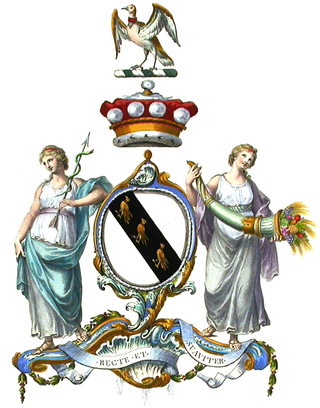
Viscount Scarsdale, of Scarsdale in Derbyshire, is a title in the Peerage of the United Kingdom. It was created in 1911 for the prominent Conservative politician and former Viceroy of India George Curzon, 1st Baron Curzon of Kedleston, who was created Earl Curzon of Kedleston at the same time and was later made Marquess Curzon of Kedleston.

Viscount St Davids, of Lydstep Haven in the County of Pembroke, is a title in the Peerage of the United Kingdom. It was created in 1918 for John Philipps, 1st Baron St Davids. The Philipps family descends from Sir John Philipps, who represented Pembrokeshire in the House of Commons. In 1621 he was created a Baronet, of Picton Castle in the County of Pembroke, in the Baronetage of England. His grandson, the third Baronet, also sat as Member of Parliament for Pembrokeshire. He was succeeded by his son, the fourth Baronet. He represented Pembroke and Haverfordwest in Parliament. His son, the fifth Baronet, sat for Haverfordwest. He was succeeded by his younger brother, the sixth Baronet. He represented Carmarthen, Petersfield and Pembrokeshire in the House of Commons.

Baron Kenyon, of Gredington, in the County of Flint, is a title in the Peerage of Great Britain. It was created in 1788 for the lawyer and judge Sir Lloyd Kenyon, 1st Baronet. He served as Master of the Rolls and as Lord Chief Justice of England and Wales. Kenyon had already been created a Baronet, of Gredington in the County of Flint, in 1784. His grandson, the third Baron, briefly represented St Michael's in the House of Commons. His grandson, the fourth Baron, held minor office in the governments of Lord Salisbury, Arthur Balfour and David Lloyd George and also served as Lord Lieutenant of Denbighshire. In 1912 Lord Kenyon assumed by Royal licence the additional surname of Tyrell. As of 2023 the titles are held by his great-grandson, the eighth Baron, who succeeded his brother in that year.

Baron Newborough is a title that has been created twice in the Peerage of Ireland; both titles are extant. The first creation came in 1716 in favour of George Cholmondeley, later 2nd Earl of Cholmondeley. See Marquess of Cholmondeley for further history of this creation.
Baron Acton, of Aldenham in the County of Shropshire, is a title in the Peerage of the United Kingdom. It was created on 11 December 1869 for Sir John Dalberg-Acton, 8th Baronet, a prominent historian and Liberal Member of Parliament.
Baron Wenlock is a title that has been created three times, once in the Peerage of England and twice in the Peerage of the United Kingdom. The first creation came in 1461 when the soldier Sir John Wenlock was summoned to Parliament as Lord Wenlock. However, he was childless and on his death in 1471 the title became extinct.
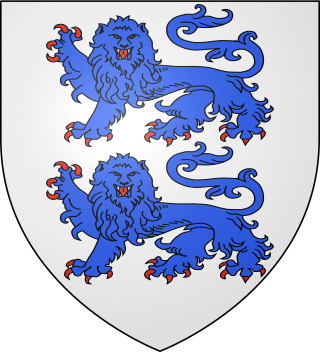
There have been two baronetcies created for members of the Hanmer family of Flintshire, Wales, one in the Baronetage of England and one in the Baronetage of Great Britain. Only one creation is extant as of 2008. The third Baronet of the second creation was elevated to the peerage as Baron Hanmer in 1872, a title which became extinct in 1881. The family name derived from the manor of Hanmer in the Diocese of St. Asaph.
There have been two baronetcies created for people with the surname Heathcote, both in the Baronetage of Great Britain and both created in 1733. The holders of the first creation were later elevated to the peerage as Baron Aveland and Earl of Ancaster, which titles are now extinct. However, both baronetcies are extant as of 2008.

Edward Pryce Lloyd, 1st Baron Mostyn, known as Sir Edward Lloyd, 2nd Baronet from 1795 to 1831, was a British politician.
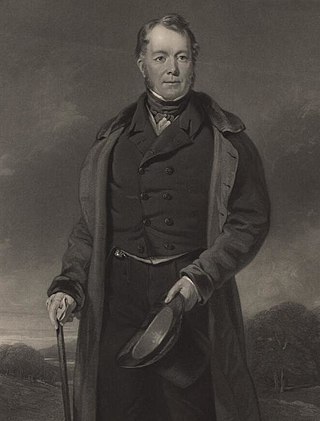
Edward Mostyn Lloyd-Mostyn, 2nd Baron Mostyn, was a British peer and Member of Parliament (MP).
Thomas Edward Mostyn Lloyd-Mostyn, was a British Liberal Party (UK) Member of Parliament (MP).

The Mostyn baronets are two lines of Welsh baronets holding baronetcies created in 1660 and 1670, both in the Baronetage of England. One creation is extant as of 2015. The two lines are related and both claim descent from Edwin of Tegeingl, an 11th-century lord of Tegeingl, a territory which approximates modern Flintshire.
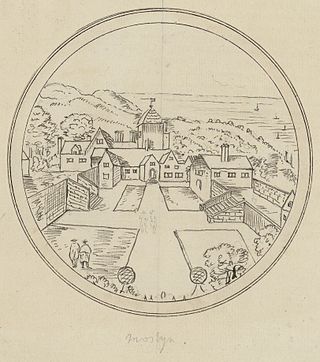
Sir Roger Mostyn, 5th Baronet was a Welsh landowner and politician who sat in the House of Commons for 38 years from 1758 to 1796.
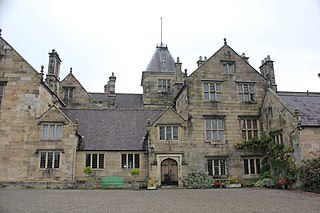
Sir Thomas Mostyn, 6th Baronet of Mostyn Hall, Flintshire and Gloddaeth Hall, Caernarvonshire, was a Welsh Member of Parliament.